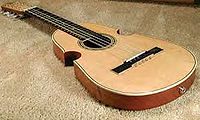| Music Information about your Country |

|
 |
Links: |
Sweden: Traditional Swedish music often uses the dance form of the polska. This polyrhythmic music is the dominant dance form of the people. This music features rich use of the fiddle and unique vocal styles. Music of all types is very popular in Sweden and at least 2/3s of school aged children in Sweden play an instrument or sing in a choir. In the north, the Saami people sing joiks that are derived from cattle calls. The fiddle tunes are often in triple meter with embellished melodies and can have leaps of an octave or more. Some Swedish instruments: Fiddle Lur: A wooden horn covered with birch bark accordian dulcimer India: The way that Indian music is organized is very different from anything that people in the west are accustomed to. There are two main patterns: Ragas for melodies and Talas for rhythms. The harmony is based on a drone instrument playing the tonic and the fifth. Once the tala has been established, the musician then improvises and decorates the strict tala. The same is true of the Ragas which are based on a scale very different than our major and minor scale in the west. The two main traditions of music in India are the Hindustani in the north and the Carnatic in the south. The Hindustani melody instrument is the sitar and the Carnatic melodies are played by the vina. Some Indian instruments: Tabla: a pair of drums played with the palms and knuckles Sitar: stringed instrument with 7 main strings and 13 others to pick up vibrations. Tambura: a stringed ‘drone’ instrument mridangam: two headed barrel drum Brazil: Brazil has one of the most multi-cultural populations in the world. There are many Portuguese and those with ancestors from other parts of Europe, as well as those of mixed European and African heritage and direct African heritage. Although music tastes in Brazil can be equally diverse, Samba is the style of music that Brazil is most famous for. Samba is very syncopated and percussive music with call and response playing and singing. The ensembles that play this music are called “Samba Schools” and they have musicians with barrel drums, snare drums, hand drum and other percussion instruments. This is also the music of Carnival which is similar to Mardi Gras in New Orleans, but the true focus at Carnival is the performance of Samba music! The sources of this sound are a blend of AmerIndian, Portuguese and African, and whether Samba or not, music is everywhere in Brazil. Some Brazilian instruments: Agogo: gongs used for generations Repinique: a two headed metal drum carried on straps and played with a stick Ganza: A cylindrical rattle with stones or metal beads Cuica: a friction drum used in Samba Hawaii: Hawaiian music can be put into 4 categories: traditional music from pre-European times which used poetic chants, music which has evolved with Western pitches and harmonies, folk music which was influenced by Protestant hymns, pop and country music and tourist music which emphasizes instrumental accompaniment, danced pantomime with costumes and dramatization. All vocal music is based on poetry and called “mele”. These songs developed harmonized melodies and are often accompanied by the ukelele or slack key guitar. Although most of the music tradition in Hawaii is vocal, there are instruments indigenous to the islands. True Hawaiian instruments: Puili: split bamboo beaters, played in pairs by tapping one another Uliuli: gourd rattle Ilili: double pair of smooth lava pebbles that are clicked together Pahu: Cylindrical skin-head drum Developed Hawaiian instruments: Ukelele: Version of the Portuguese mandolin Ki ho’alu: Hawaiian slack key guitar |